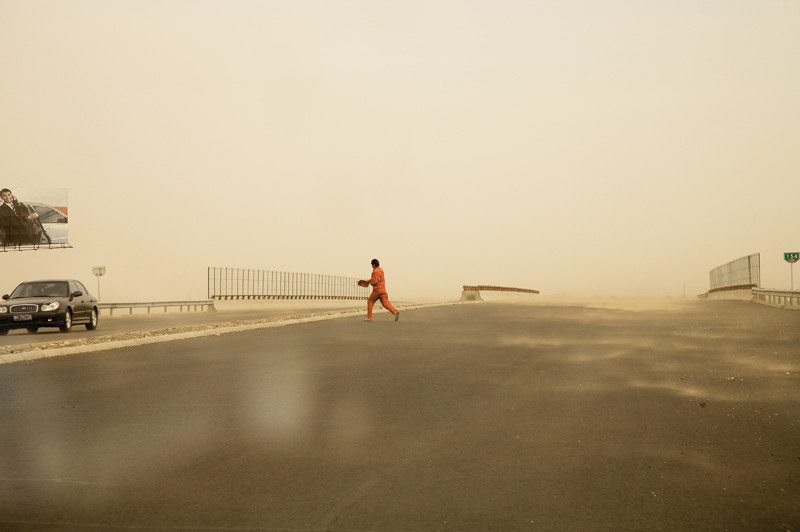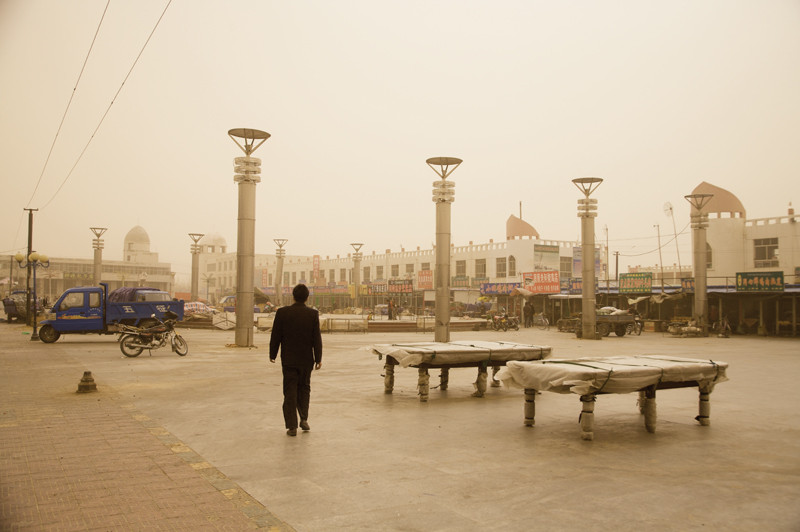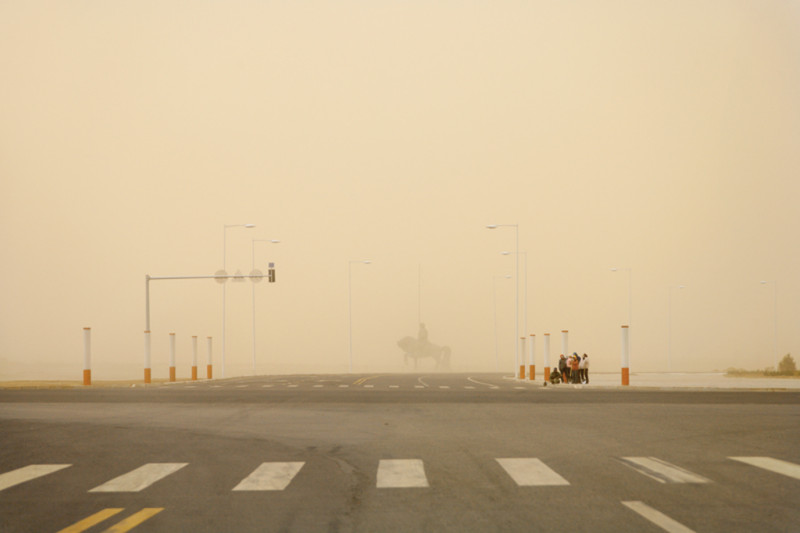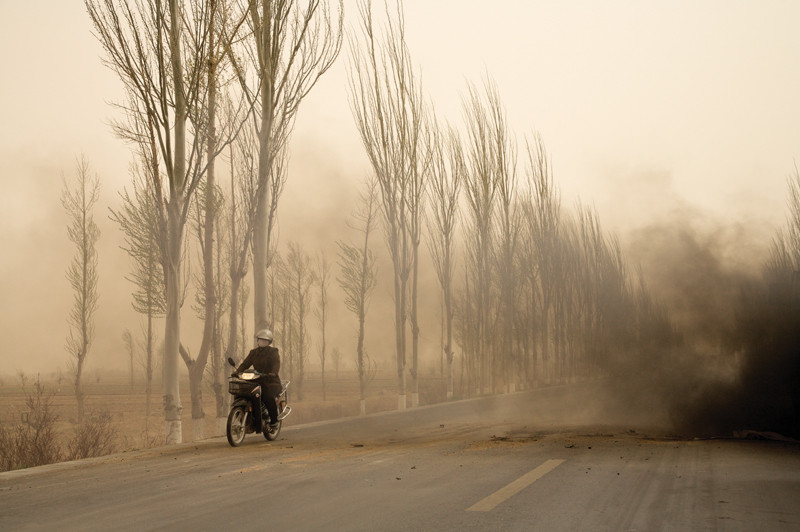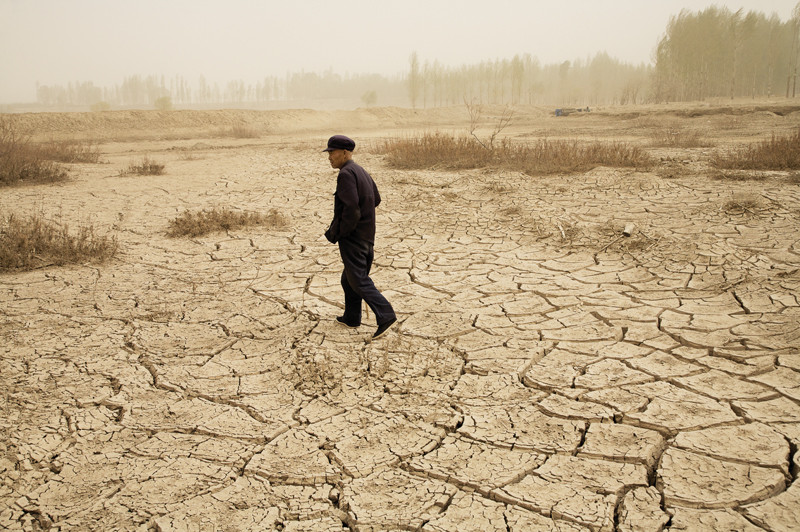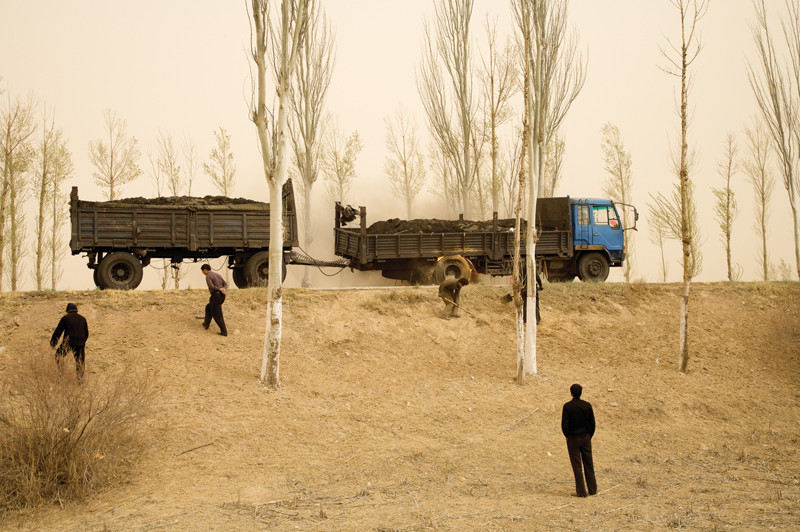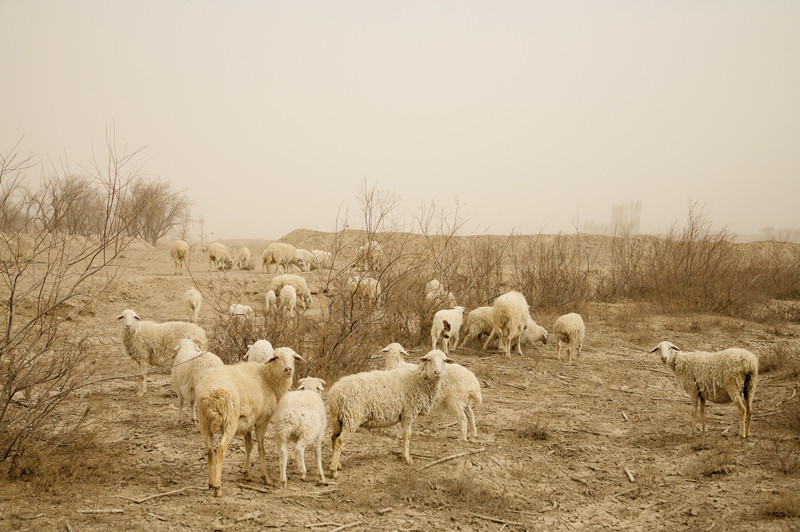[Spring 2009]
In November 2008, Benoit Aquin won the prestigious Prix Pictet for his series on desertification and dust storms in China. One of the greatest environmental disasters of our time, the Chinese “Dust Bowl” is probably the largest conversion of productive land into sand anywhere in the world. In November 2008, Benoit Aquin won the prestigious Prix Pictet for his series on desertification and dust storms in China. One of the greatest environmental disasters of our time, the Chinese “Dust Bowl” is probably the largest conversion of productive land into sand anywhere in the world. Of the deserts that cover 18% of China today, 22% were created by humans. These new deserts create dust storms that presently affect three hundred million people in China. Entire cities have been created for ecological refugees. To raise awareness of this environmental disaster, Aquin produced impressive and troubling images of a landscape entirely homogenized and shaded by dust storms.
by William A. Ewing
For twenty years, Benoît Aquin has travelled widely, armed with a global vision and the determination to construct a global project. From initial forays into the Caribbean in the late 1980s (notably Haiti, where he focused on the practice of voodoo, a project that he would extend over the next ten years), through photographing the banana plantations of Nicaragua, to recording the drastic effects of climate change in northern Quebec, Aquin’s work has always been characterized by a deep concern with the environment and humankind’s increasingly devastating impact on it.
Aquin can be said to belong to the distinguished tradition of “concerned photography”; [he believes] depicting the urgency of problems and then galvanizing people into action.
Not content with an exclusive focus on the North–South axis, Aquin has over the past decade travelled east, first to Mongolia in 2002, and then to China, the site of his award-winning work on what he calls the Chinese Dust Bowl. Most recently, he has begun work in Egypt, seeking out densely populated environments along the Nile that are being stressed to the breaking point. Aquin hesitates when asked if any of these diverse projects are “complete”; their complexity is sufficiently daunting that he prefers to characterize them as “works in progress.” One senses that he likes to bring the various projects forward simultaneously, working on one, then shifting to another, and so on. He relishes the contrasts and profits from the synergies.
Unlike many documentary photographers, who believe that bringing a sharp eye to any difficult subject is all that is required, Aquin studies his topics in depth before ever picking up his camera. An avid reader, he is as likely to cite writers as visual artists among his influences. He is grateful to such authors as the agronomist Lester Brown – a “visionary” in Aquin’s view; the Le Monde journalist Hervé Kempf, who has written so effectively of the threats to the biosphere, notably in Comment les riches détruisent la planète; and “ecocity builder” Richard Register, whose visionary work on the centrality of cities Aquin greatly admires. Marcel Mazoyer and Laurence Roudart’s History of World Agriculture is of particular significance to him, giving sense and urgency to his project; if there is a central focus to his work, it is agricultural – specifically, the looming food crisis.
To some degree, Aquin can be said to belong to the distinguished tradition of “concerned photography” that has fallen out of fashion: environmental and social issues do concern him, and he does believe that photography is particularly well suited to depicting the urgency of problems and then galvanizing people into action. However, he is as likely to acknowledge Richard Misrach’s Desert Cantos as exemplary as Gilles Peress’s Telex Iran. The poetics of photography are high on his list of desirable attributes, and Robert Frank and Frederick Sommer are constant sources of nourishment. Closer to home, Aquin cites the reclusive Montreal photographer John Max as a major influence; in Aquin’s view, there is rare honesty in everything before Max’s lens, a value worth emulating. What these “influences” have taught Aquin individually is difficult, perhaps impossible, to explain with any precision, but what they all have in common, he feels, is an interest in fundamental human concerns, but seen tangentially – or, in his words, “made visually interesting and palpable without making it all literal.” But Aquin’s eclecticism stops short of the distanced and sardonic references of much contemporary practice, in which, as Adam Weinberg has put it, “Style often overpowers meaning; or, historians and critics such as Szarkowski have chosen to interpret photographs in such a way that ‘the look’ has come to outweigh that which is looked at.” Aquin, I believe, is striving for an equivalence.
There is a mystical aspect to Aquin’s work as well. The rational, intellectual work comes before and after the shooting (reading, conceiving, planning, then afterwards selecting, editing, etc.) But with the shooting itself, the photographer moves onto an intuitive plane, “flirting with the essence of things….
I am wholly engrossed when I’m working. I forget everything else. It’s like making love, you abandon yourself.” He often recalls the impact of a Robert Frank image that he came upon as a teenager; the expressivity possible in a photograph astonished him. Later, having decided to become a commercial photographer, he had a similar epiphany on seeing Gilles Peress’s Telex Iran. It was possible, he realized, to work in both a spiritual and an intellectual way. The commercial road would be abandoned, and more exotic routes explored.
Travelling in Mongolia in 2002, Aquin crossed the Gobi Desert and began to understand the implications of desertification. This led to his decision to focus on the food crisis, and more immediately, to his specific interest in the Chinese dust storms – a misnomer, in fact, as it is a matter of the topsoil having been stripped off by the wind due to badly conceived agricultural policies and programs. There is a great beauty to these images – a kind of Turneresque swirl of form in which people have little more substance than insects – but this beauty is held in check by the reality of what we’re looking at: catastrophe, in fact, as a ballooning Chinese population squeezes (or is squeezed) onto land surfaces that can’t possibly support it in the long term. Anne Tucker once wrote something about Misrach’s distressed landscapes that seems to apply to Aquin’s dust storms. Tucker observed that landscape in Western art had become lazy, “a kind of mental picnic,” and she applauded Misrach for finding “politics in its most virulent and secret forms out here.” Thus, the landscape is no longer a neutral, inert given, “but a threatened territory.”
Mazoyer and Roudart conclude their magisterial book with a pertinent reminder: “In truth, this world, which is crumbling today from the bottom much more quickly than it is being built from above, has become a colossus with clay feet, a cracked colossus whose foundation must be reconstructed in all its urgency.” Acquin’s dust bowl pictures – a world, so to speak, “on fire” – second the point. But they are best appreciated in comparison with a body of work at another extreme – Aquin’s work with hunters in northern Canada who are finding that their traditional hunting grounds are stressed to the breaking point. The “hot” and “cold” of Aquin’s photography recall the famous end-of-the-world imaginings of Robert Frost, whose poem now seems more apt than ever:
Some say the world will end in fire,
Some say in ice.
From what I’ve tasted of desire,
I hold with those who favour fire.
But if it had to perish twice,
I think I know enough of hate,
To say that for destruction
Ice is also great, and would suffice.
Always with an eye on humanitarian issues, Benoît Aquin has created important photographic essays on subjects such as the pesticide crimes of Nicaragua, the melting ice floes in the Canadian North, and the drastic desertification of China. This photojournalistic work, published in major magazines and newspapers, has earned him numerous prizes. For more than fifteen years, Aquin also worked also as a staff photographer for alternative news weeklies Voir and Hour and the independant magazine Recto Verso, while exhibiting his work in museums, artist-run centres, and private galleries across the country. He is represented by Gallery Pangée, in Montreal, and Stephen Bulger, in Toronto.
William A. Ewing is a noted authority in photography. He is the author of numerous books and has curated exhibitions for many of the world’s museums in Europe and North America. The founder of Optica, in Montreal, he has been director of exhibitions for the International Center of Photography, New York, and for the past twelve years he has been the director of the Musée de l’Elysée, Lausanne, Switzerland. He lectures internationally and teaches at the University of Geneva.
The World’s Premier Photographic Award in Sustainability.
The Prix Pictet is a major new global prize in photography, sponsored by Pictet & Cie, a private bank in Geneva, in association with the Financial Times of London. With a single annual prize of CHF 100,000, the Prix Pictet will reward photographers and the images they use to tell stories of urgent global significance. Each year, the Prix Pictet will focus on a distinct sustainability theme. The theme for 2008 was water.
Benoît Aquin is the first recipient of this prestigious award. He was selected from among some 200 photographers from 43 countries, nominated by a panel of 49 visual arts experts from six continents, and judged by a panel of 7 experts. For more information: prixpictet.com.

